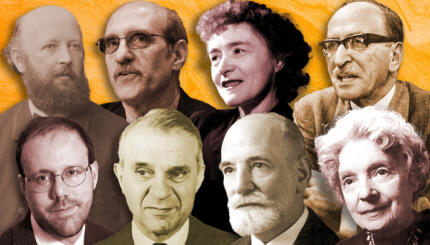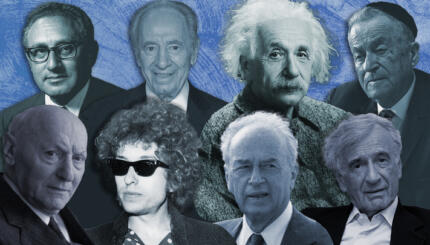By the late 1950s, Anne Frank had become a legend: known around the world not only as the author of a vivid, life-affirming book, but also as the prime symbol of the sufferings of innocent victims of Nazi genocide. “One voice speaks for six million,” the Russian writer Ilya Ehrenburg wrote, “the voice not of a sage or a poet but of an ordinary little girl.”
Streets, schools, youth villages and forests were soon named in her honor; paintings and statues perpetuated her image; poems and songs were composed in her memory; and — as Alvin Rosenfeld, director of Indiana University’s Institute for the Study of Contemporary Anti-Semitism, has observed — “public figures of every kind, from politicians to religious leaders, regularly invoke[d] her name and quote[d] lines from her book. In all of these ways, her name, face, and fate [were] kept constantly before us.”
In 1957, Otto Frank had further memorialized his daughter by helping to establish the Anne Frank Stichting in Amsterdam, a foundation whose original aim was “to repair and renovate the property at 263 Prinsengracht and especially to maintain the building’s back annex, as well as to propagate ideals left to the world in the diary of Anne Frank.” In May 1960, the Anne Frank House opened as a museum, and the foundation supported youth conferences, lectures and exhibitions designed to combat anti-Semitism and racism. Activities soon expanded. A specialized library brought together a collection of books, newspapers and magazines about discrimination and threats to the rights of minorities; and the educational department developed programs, courses, and teaching aids to be used in schools and other settings.
In 1985 the traveling exhibition “Anne Frank in the World: 1929-1945” was organized by the Foundation and has since been seen (and will continue to be seen) in hundreds of cities and towns across Europe, North and South American, and Asia. The number of visitors to the Anne Frank House has grown from about 9,000 in 1960 to more than 600,000 each year in the 1990’s, making it something of a shrine, as well as one of the most popular museums in Europe. Anne Frank Centers were also established in New York and other cities, and at this writing one is planned for Berlin. In Basel, the ANNE FRANK-Fonds oversees matters related to copyrights andn reprint permissions, and also supports educational and philanthropic projects. (See Anne Frank House: A Museum with a Story. Amsterdam, 1992.)
Such has been the phenomenal fame of Anne Frank’s life and diary, and so often has she been invoked as the Holocaust martyr–symbol of the murdered, guiltless six million Jews–that critical reactions were and continue to be inevitable. As early as the late 1950s, neo-Nazis–in their efforts to prove that accounts of German genocide were exaggerated or even fabricated–claimed that the most famous Holocaust document, the diary itself, was a forgery. These frequently repeated charges led to several lawsuits and in the 1980’s to an exhaustive scholarly and forensic study by the Netherlands State Institute for War Documentation to authenticate Anne Frank’s writings. The result was the authoritative The Diary of Anne Frank: the Critical Edition, which proved beyond a doubt that the diary was genuine and that the neo-Nazi allegations were groundless.
Published first in the Netherlands (1986) and then in Germany, France, Italy and America, the Critical Edition is now recognized as the most reliable source for the text and history of the girl’s writings. (See Deborah Lipstadt, Denying the Holocaust, New York, 1993.) Revised and expanded editions of the diary for general readers followed; and in this new form the book again became an international best-seller. (Anne Frank: The Diary of a Young Girl, edited by Otto H. Frank and Mirjam Pressler, newly translated by Susan Massotty, New York, 1995.)
Other, more creditable critiques of the so-called “mythologizing of Anne Frank” followed in the 1970s and afterwards. Although people continued to revere the girl and to treasure her book, commentators questioned the many, often bizarre uses to which her name and image had been put. Frequently quoting Hannah Arendt‘s 1962 remark that the adoration of Anne Frank was a form of “cheap sentimentality at the expense of great catastrophe,” critics argued that an adolescent Dutch girl could not possibly be “the voice of the six million”; no single person could.
Her diary, which ended before she knew about or experienced German genocide, did not convey the horrific actuality or meaning of an unprecedented historical disaster in which millions of individuals and much of their culture were obliterated in camps built and operated by one of the great nations of Europe. Her book could not and should not be described as the representative Holocaust text. To focus solely on Anne Frank as a symbol of the victims of the Holocaust is, critics argue, to turn an enormous calamity into a story of an assault on fugitives and innocent children rather than of a systematic effort to eradicate an entire people and culture.
Another aspect of the ongoing controversy about the Anne Frank legacy concerns the Jewish specificity of the diary. The best-known adaptations (the Goodrich and Hackett play and the George Stevens film) minimized the Jewish content in order to achieve a greater universality and hence consolation and commercial success. For years after the premiere of the play and film, the heroine was widely perceived not only as a symbol of the Holocaust but as a ubiquitous emblem of hope, a persecuted victim whose utterance “In spite of everything, I still believe that people are really good at heart” encapsulated her inspirational message to the entire world.
That Anne Frank was Jewish and killed for that reason only became less significant than the comforting image of her as the ardent child who, during a barbaric time, never lost faith in the basic goodness of human beings. In the diary itself, however, Anne writes powerfully of the suffering of European Jews and ponders the reasons for their persecution. Also neglected in the Broadway/Hollywood account of the girl who kept faith is the fact that she wrote the much-quoted sentence before she was arrested and condemned to see mass murder, and before she herself died wretchedly in Bergen-Belsen. As Lawrence Langer has said, the acclaimed sentence (yoked from context and used as the uplifting curtain line of the Goodrich and Hackett play) “floats over the audience like a benediction assuring grace after momentary gloom,” and is “the least appropriate epitaph conceivably for the millions of victims and thousands of survivors of Nazi genocide.”
Other controversies have swirled around the name “Anne Frank,” some of which provoked bitter quarrels and lawsuits. During Otto Frank’s lifetime, he was frequently involved in litigation against the individuals and groups who charged that his daughter’s diary was a forgery; and in recent years disputes have arisen between the Anne Frank Stichting in Amsterdam and the ANNE FRANK-Fonds in Basel over copyrights, the uses of money generated by the vast sales of the diary, and other matters related to ownership of the child’s name, image and book, and to the question of how her life and death should be memorialized. Survivors of the camps and others have also expressed indignation and sadness at what they see as the exploitation of an Anne Frank cult.
Persistent efforts, however, have also been made to counter the most sentimental and misleading aspects of the “Anne Frank mystique.” Two school curricula were designed to place her story more accurately in context: Karen Shawn’s The End of Innocence: Anne Frank and the Holocaust (New York, 1989, 1994); and Alex Grobman’s Anne Frank in Historical Perspective (Los Angeles, 1995). Alvin H. Rosenfeld’s valuable essay, “Popularizaton and Memory: The case of Anne Frank,” appeared in Lessons and Legacies (Northwestern, 1991); and Robert Alter has usefully warned of the false consolation involved in trying to clutch “eternal hope from the heart of hell.”
Yet despite some of the questionable uses to which the Anne Frank legend has been put, her book and legacy remain of permanent value. The diary itself is a profoundly moving testament to the fine observational powers and the swift growth of a quicksilver young girl, and to the pathos of her brutally abbreviated life. If read as the first (and not the only, the last, or the definitive) book about people persecuted by the Nazis, it can fairly serve as an unforgettable reminder of what Philip Roth once called “the millions of unlived years robbed from the murdered Jews.”
Reprinted with permission from The Holocaust Encyclopedia (Yale University Press).



